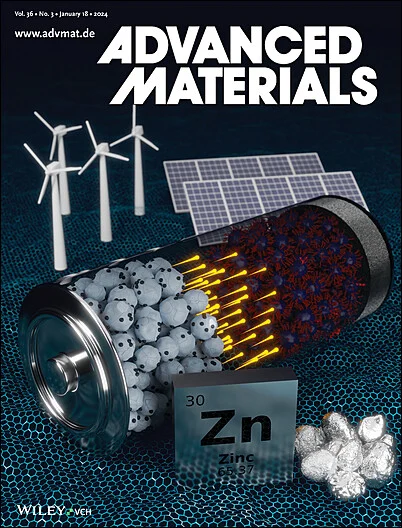Orientation-Selective Memory Switching in Quasi-1D NbSe3 Neuromorphic Device for Omnibearing Motion Detection
IF 27.4
1区 材料科学
Q1 CHEMISTRY, MULTIDISCIPLINARY
引用次数: 0
Abstract
Intelligent neuromorphic hardware holds considerable promise in addressing the growing demand for massive real-time data processing in edge computing. Resistive switching materials with intrinsic anisotropy and a compact design of non-volatile memory devices with the capability of handling spatiotemporally reconstructed data is crucial to perform sophisticated tasks in complex application scenarios. In this study, an anisotropic resistive switching cell with a planar configuration based on lithiated NbSe3 nanosheets is demonstrated. Benefitting from the highly aligned diffusive channel associated with a quasi-1D van der Waals structure, the memristor patterned along NbSe3 atomic chains presents robust memory switching behavior with superior stability, particularly the low set/reset voltages (0.4 V/−0.36 V) and extremely small standard deviation (0.041 V/0.051 V), among the best compared to state-of-the-art devices. More importantly, unlike traditional resistive switching materials, anisotropic ion migration in NbSe3 crystals leads to a high orientation selectivity in the conductance update. Custom-designed neuromorphic hardware contributes to the implementation of omnibearing motion recognition for automatic pilot applications, yielding a high accuracy of 95.9% considering variations. This article presents a new strategy based on NbSe3 crystals to develop a neuromorphic computing system with intelligent application scenarios.

用于全向运动检测的准一维 NbSe3 神经形态器件中的方向选择性记忆切换
智能神经形态硬件在满足边缘计算对海量实时数据处理日益增长的需求方面大有可为。具有固有各向异性的电阻开关材料和设计紧凑、能够处理时空重构数据的非易失性存储器件,对于在复杂的应用场景中执行复杂的任务至关重要。在这项研究中,我们展示了一种基于锂化硒化铌纳米片的各向异性电阻开关单元。得益于与准一维范德瓦耳斯结构相关的高度排列的扩散通道,沿硒化铌原子链图案化的忆阻器表现出稳健的记忆开关行为和卓越的稳定性,尤其是较低的设定/复位电压(0.4 V/-0.36 V)和极小的标准偏差(0.041 V/0.051 V),与最先进的器件相比名列前茅。更重要的是,与传统的电阻开关材料不同,NbSe3 晶体中各向异性的离子迁移导致电导更新具有很高的方向选择性。定制设计的神经形态硬件有助于为自动驾驶应用实现全向运动识别,考虑到各种变化,准确率高达 95.9%。本文介绍了一种基于 NbSe3 晶体的新策略,用于开发具有智能应用场景的神经形态计算系统。
本文章由计算机程序翻译,如有差异,请以英文原文为准。
求助全文
约1分钟内获得全文
求助全文
来源期刊

Advanced Materials
工程技术-材料科学:综合
CiteScore
43.00
自引率
4.10%
发文量
2182
审稿时长
2 months
期刊介绍:
Advanced Materials, one of the world's most prestigious journals and the foundation of the Advanced portfolio, is the home of choice for best-in-class materials science for more than 30 years. Following this fast-growing and interdisciplinary field, we are considering and publishing the most important discoveries on any and all materials from materials scientists, chemists, physicists, engineers as well as health and life scientists and bringing you the latest results and trends in modern materials-related research every week.
 求助内容:
求助内容: 应助结果提醒方式:
应助结果提醒方式:


